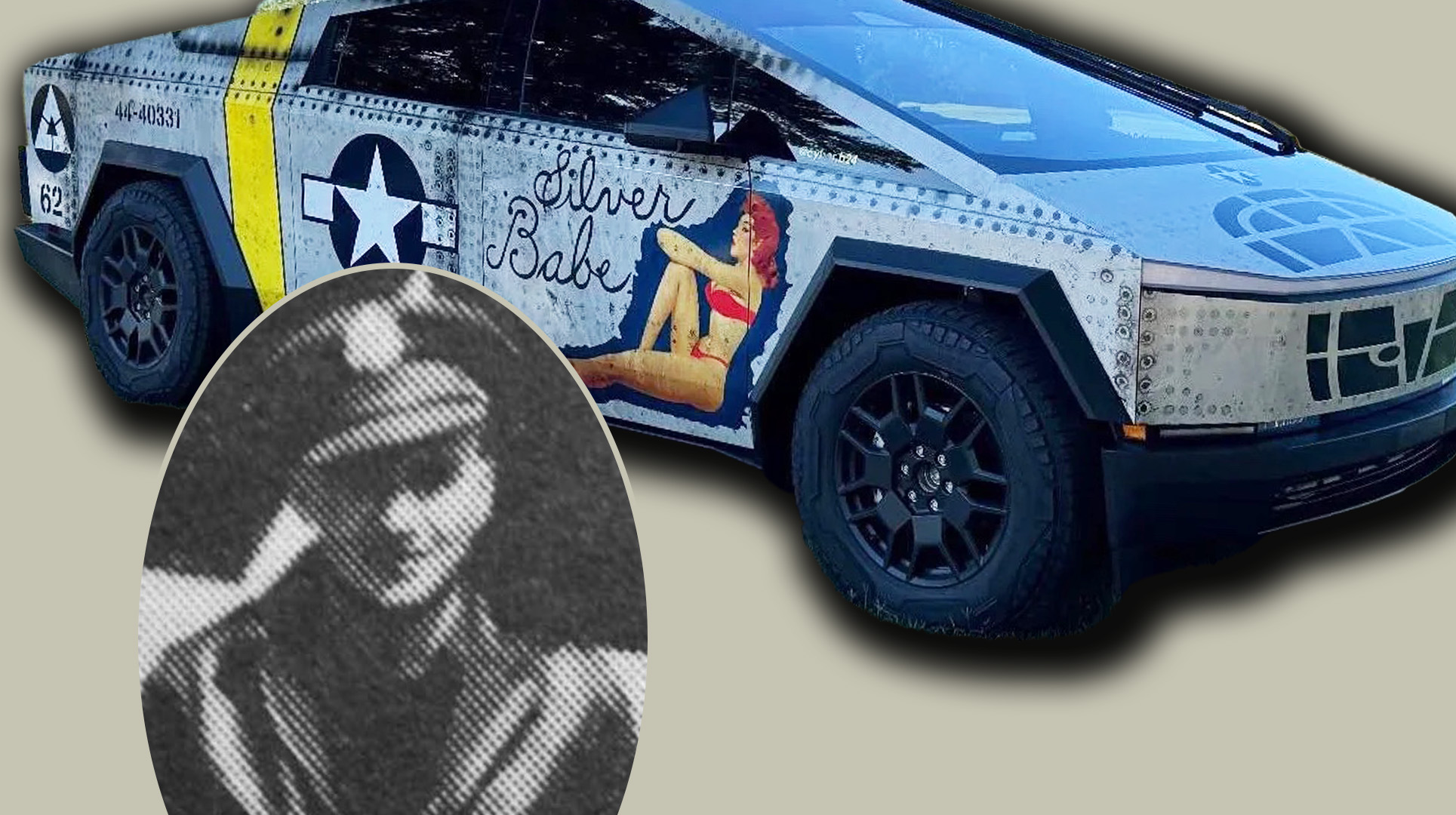
A North Carolina man has put a unique, historically-accurate wrap over his Tesla Cybertruck that honors the WWII bomber his grandfather piloted for 50 missions over Europe. The futuristic truck famously comes with no paint job on its all-aluminum body, a visual match to the skins of many B-24 Liberator bombers — including one B-24 whose crew dubbed it the “Silver Babe” assigned to the 449th Bomb Group in Grottaglie, Italy in 1944.
The pilot of Silver Babe was 1st Lt. Ken Kinsinger, the owner’s grandfather.
The owner of the all-electric vehicle decided to put a full-body wrap over the truck that features a near-perfect recreation of Silver Babe’s nose art, along with other distinctive unit markings. The wrap job uses the Cybertruck’s aluminum surface to simulate the B-24’s own aluminum surface, and even adds faux-rivets and traces of smoke and oil. A pattern on the hood recreates the B-24’s array of nose windows.
Though most B-24s were painted green during the war, the “Silver Babe” got its nickname because it remained — like the Cybertruck — paint-free. The plane was the 449th’s first all-aluminum ship with its silver coloring standing out among the sea of olive bomber planes. The non-painted bomber planes were actually a point of contention among crews who feared the lack of camouflage made them easier targets. Others argued that the paint was a waste of resources and cost precious time in the U.S. factories churning out planes as fast as possible. Studies by the Air Force found that the painted planes actually allowed certain aircraft like the B-17 to fly faster.

The truck’s owner has posted photos of the truck on Reddit and maintains an instagram account for it. The anonymous owner said he lives in the Raleigh, NC region but did not respond to direct messages and emails from Task & Purpose.
50 Combat Missions
Kinsinger was the pilot of Silver Babe’s 10-man crew. The same group picked it up from the factory, ferried it to Italy and flew it on 50 missions over enemy territory.
In 2004, at 88 years old, Kinsinger was awarded a Distinguished Flying Cross for piloting the Silver Babe on “an exceptionally dangerous mission” over the oil fields of Ploesti, Romania, in July 1944, according to an Air Force release. He flew the mission as the wing’s lead bomber with the wing commander, a colonel, alongside him in the cockpit.
The oil fields were a major target for the U.S. military at the time since the Romanian refineries produced 80% of Germany’s crude oil. Over the course of the war, 15th Air Force crews dropped more than 13,000 tons of bombs on the Ploesti oil fields which cost them 350 heavy bombers and more than 3,000 casualties.

As they approached the target, enemy fire took out the B-24 engine’s turbo-chargers, causing the bomber to lose altitude. The flak was in front of the aircraft and took out the plane’s front Plexiglass but the crew continued on to lead the bombing raid. The group destroyed the oil refinery and was awarded the Presidential Unit Citation for the mission.
Subscribe to Task & Purpose today. Get the latest military news and culture in your inbox daily.
He was also awarded an Air Medal with three oak leaf clusters for completing 50 missions during his 1944 tour.
As a B-24 pilot, Kinsinger’s survival was a feat in itself. The 15th Air Force, which operated out of southern Europe, lost half of its fleet and crews in less than a year and a half, Lt. Gen. Bruce Wright, Air Combat Command vice commander, said at the ceremony honoring Kinsinger. During WWII, more than 52,000 airmen died in combat operations. A website dedicated to 449th history notes that Kinsinger’s unit alone lost 135 aircraft, with 393 crew members killed in action, 359 shot down and captured and 186 shot down who evaded capture and reached friendly territory.

Silver Babe was integrated into the 449th Bomb Group as a replacement ship flown in by Kinsinger and his crew from the now-decommissioned Hamilton Air Force Base, California. As novice pilots and crew, they ferried the plane from California to Brazil and then on a nightime, 12-hour, over-water flight to Europe before reaching their base in Italy.
But while Kinsinger and his crew made it home, Silver Babe did not. The plane was lost in December 1944 in the Yugoslavian mountains after suffering heavy flak damage over the oil refinery at Moosbierbaum, Austria. The entire crew bailed out and were returned by Yugoslavian Partisans on Jan. 5. 1945.
Kinsinger passed away in 2007, according to an online obituary.
